Development of Footwear Business Model
Info: 5894 words (24 pages) Dissertation
Published: 9th Dec 2019
Tagged: Business Strategy
Executive Summary
The report is commissioned by CEO Mr Brown to develop a feasible footwear business model and analyse the impact of disintermediation and how to apply the analysis of clickstream behaviour.
This report refers to three aspects including disintermediation, business model and clickstream behaviour. I have researched relevant literature and case analyses concerning different aspects and come to the conclusion.
Disintermediation has always been a topic with the development of e-commerce. We conduct research on literature to understand its extent and impact in different fields. There are two kinds of disintermediation; one bypasses parts of intermediaries, another one cuts out all the middlemen. Our business belongs to the former that can reduce intermediate costs and the burdens of manufacturers and keep price competitiveness.
Business model is the core of a business plan and involves multiple aspects, such as competitive advantage and market strategy. With the purpose of planning a feasible model, we do research on online consumer reports to realise the attitudes and motivates of consumers. Then study the measures that could attract visitors, turn them into customers and retain customers in order to develop a suitable market strategy. Furthermore, research the literature about organisational development. Based on our research, we define the business model from five aspects including value proposition, revenue model, competitive advantage, market strategy and organisational development. In this model, our value proposition is to provide customers with a wide range of low price products, fast shipping, excellent pre-sales and after-sales service. These are also our competitive advantage. In addition, our market strategy is to make full use of internet-based search engines and social media to boost the traffic and convert audiences to customers. Moreover, we will establish a flat organisational structure and people-centric workplace culture to ensure efficient communication and operation.
To improve the performance, we can draw upon the analysis of clickstream behaviour. I conduct research on some clickstream literature, analysis tools and a couple of cases in which some companies are using clickstream data to improve their performance. Then we are sure that we can do a lot of things to boost sales performance with the clickstream technology, such as planning more popular promotional campaigns, improving the design of our website and distinguishing different consumer groups to facilitate targeted advertising.
TABLE OF CONTENTS
2. The Analysis of Disintermediation
2.2 The Impact of Disintermediation
3.5 Organisational Development
1. Introduction
Over the past more than 20 years, e-commerce has experienced multiple stages of development including invention, consolidation, reinvention (Laudon & Traver 2017). It has largely changed the traditional business model. And many companies have moved their business to e-commerce. Especially in the past few years, as the proliferation of mobile terminals, e-commerce has been changing the lifestyle of almost everyone. Increasing people tend to shop online. Furthermore, in the footwear industry, there are still great market opportunities. So, CEO Mr Brown has commissioned me to conduct this report in order to operate our business based on e-commerce.
Due to time constraints and the extensiveness of e-commerce content, it is hard to conduct particularly accurate and detailed research. Later, we are going to continue to do further research.
At present we plan to start our business of selling shoes and associated goods relying on e-commerce. Compared to traditional market, e-commerce has many advantages, such as disintermediation and advanced web technology. First, in order to make full use of the advantages of disintermediation, we do study of the impact of it. Then we develop a specific e-commerce business model including value proposition, revenue model and so forth. Furthermore, we analyse how we can employ clickstream analytic technique to promote our business. According to our value proposition, we name our e-store ‘SHOES 4 YOU’ that means consumers can buy satisfactory shoes from us and gain high-quality service.
2. The Analysis of Disintermediation
2.1 Concept
Disintermediation is the concept of getting rid of intermediaries. At the beginning of e-commerce, some economists thought it could provide an almost perfect market environment for producers and customers. In this kind of situation, information asymmetry tended to be considerably reduced, and product information and prices were equally distributed and transparent. Producers could sell their products to hundreds of millions of consumers around the world. In turn, each consumer could buy what they want from all over the world. The direct relationships between producers and customers could reduce transaction costs and time cost. Based on this, intermediaries between manufacturers and consumers known as market middlemen would disappear (disintermediation). And manufacturer-direct companies that sell their goods directly to buyers without the involvement of middlemen were forecasted to play an important role in e-commerce businesses (Laudon & Traver 2017).
2.2 The Impact of Disintermediation
In order to discuss the impact of disintermediation, the extent of disintermediation is also a significant aspect worth discussing. In Figure2.2.1, the first one (case a) is the traditional mode without cutting out middlemen. Case b and c are two kinds of disintermediation, the case b only removes the wholesaler and the case c cuts out all intermediaries (Chaffey 2009). These two types of disintermediation both exist in the e-commerce field.
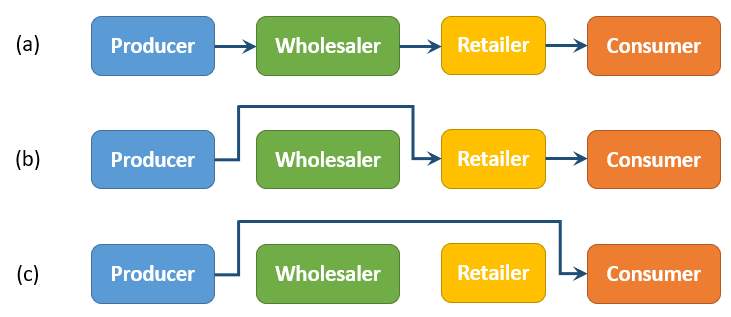
Figure 2.2.1 Disintermediation
Dell is a typical example of disintermediation. It offers computers directly to consumers through its e-commerce store and provides customers with the opportunities of personalizing their computers. After consumers place orders, Dell will produce and deliver straight to the customers according to the order quantity. Compared to other computer manufacturers, Dell can effectively reduce inventory and transaction costs. It has reaped the benefit of offering goods directly to buyers via cutting out all traditional intermediaries.
In the footwear industry, Nike and Adidas are the leading brands of athletic footwear. They both have built their e-commerce business. And individual customers in many countries can purchase their shoes directly from the official website of Nike and Adidas. According to the calculation by eMarketer based on the Nike annual report 2017, Nike’s e-commerce sales increased 29.7% and accounted for 6.5% of its annual sales.
Therefore, disintermediation does bring businesses and consumers a lot of benefits. From an enterprise’s point of view, bypassing the intermediaries may make companies serve customers directly and establish close relationships with them. Also, reaching consumers directly may effectively reduce transaction costs, and then enable companies to offer products at lower prices and maintain competitiveness. From a consumer’s point of view, they could get goods at low prices, even customize personalized products.
From another point, disintermediation, such as the case (c), may bring some adverse effects to manufacturers. As manufacturers who only faced wholesalers or distributors before, cutting out all middlemen may largely increase the burden of operation. These companies may have to allocate more internal resources to deal with the business that was originally operated by other companies. And they may also face the challenges of retaining customers, responding quickly to users’ orders and requirements due to lack of prior direct market experience.
Our business is to purchase a wide range of brands of footwear and associated goods directly from manufacturers and sell straight to consumers. This pattern bypasses wholesalers and belongs to the case (b) type of disintermediation. We will discuss the impact on manufacturers and consumers respectively.
- For footwear manufacturers, they may not have enough internal resources to provide consumers with satisfactory service. Footwear is different from some other products, like computers and smartphones. Consumers need to choose their most suitable products. Otherwise, it will result in costly returns. So, our business can reduce the burden on producers. Also, bypassing wholesalers can decrease intermediate costs and keep price competitiveness.
- For consumers, our business can provide them with a wide variety of brands of choices at lower prices and reduce their search costs. Buyers could not only compare prices between different brands but also get professional consulting services via our customer service team.
All in all, disintermediation is not an absolute thing. The impact and extent of disintermediation depends on many aspects such as different industries, products and economic climate.
3. Business Model
Our business will focus on offering a wide variety of brands of athletic and leisure shoes and associated goods such as sports gear. And we can start our business quickly by taking full advantage of e-commerce. The first step in starting the business is to plan a business model that can demonstrate what value we are able to offer to customers, why consumers want to do business with us, what our competitive advantage is and how to achieve our objective. In the fiercely competitive environment, a feasible business model is critical. I will describe our model from the following aspects.
3.1 Value Proposition
Our value proposition ought to be in line with the psychology of people shopping online and bring them more value than other competitors. Nowadays more and more people tend to shop online. According to the 2017 global online consumer report of KPMG, the main motivators that drive consumers to shop online are lower prices, time flexibility and convenience (KPMG 2017), shown in Figure 3.1.1. If buyers could get good experiences of online shopping, they are more likely to shop online again. For the person who wants to buy a pair of athletic shoes or associated goods, our platform will provide them with a wide variety of choices at a lower price and good pre-sales and after-sales services.
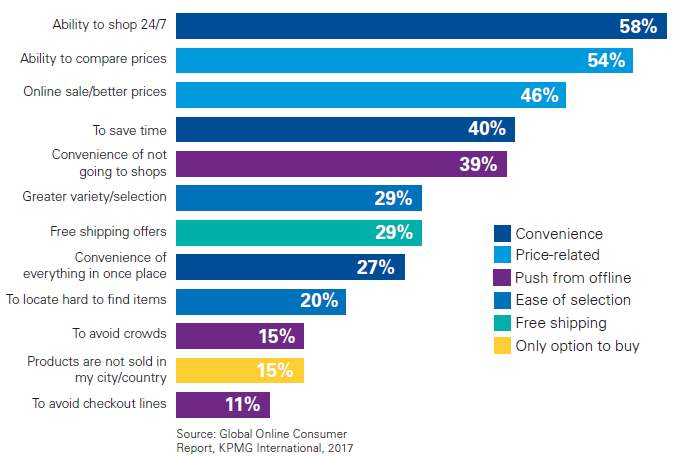
Figure 3.1.1 The Motivators of Shopping Online
So, in order to reflect the value that we can offer to our customers and give them excellent shopping experience, we define our value proposition as “Find your favourite athletic shoes, get it at a lower price and fast shipping”.
3.2 Revenue Model
Our revenue model could include sales revenue, transaction fee revenue and advertising revenue.
SALES REVENUE. At first, our revenue mainly comes from selling products. Through cutting out the intermediaries, we are able to purchase shoes and other goods directly from different manufacturers around the world and sell them to buyers. Disintermediation allows our company to reduce intermediate transaction costs and earn more profit.
TRANSACTION FEE AND ADVERTISING REVENUE. As the company’s business grows, a lot of audiences come to our website. We may provide some manufacturers with a platform for vending their products straight to consumers or advertising on our website. Then our revenue could derive from transaction or advertising fee.
3.3 Competitive Advantage
Even though e-commerce in footwear field is increasing year on year, many companies have been targeting this market niche. So, only competitive advantages can make our company grow and thrive.
- DIVERSITY. We plan to introduce a wide range of brands into our footwear business to ensure that consumers could buy satisfactory shoes. These brands include almost all the world leading brands, such as Nike, Adidas, Under Armour, PUMA and Reebok.
- FAST SHIPPING. We will apply intelligent ordering and warehouse management system to speed up order processing. Also, we will seek cooperation with New Zealand’s leading courier companies to ensure that customers can receive their products as soon as possible.
- GOOD SERVICE. In the footwear industry, the quality of service is as important as the quality of products. Providing them with good after-sale service can not only give them a good shopping experience but also increase customer loyalty.
Poor fit issues are still a major factor contributing to high returns. Therefore, prior to purchase, we will provide them with professional consulting work, and combine the latest fit technology and the size of their current shoes to help choose the best fit shoes. After receiving shoes, if they are not satisfied, we will provide a free return service.
3.4 Market Strategy
As a new e-commerce company, the sound market strategy can quickly boost our performance. We will mainly utilize the following market strategy to improve our performance.
Boost traffic. Fully make use of search engines and social media to increase the traffic.
- Search engines are significant entrances to an e-commerce store. So, we need to take a couple of measures to improve search ranking, such as properly using meta tags and advertising on Google.
- Social media play an increasingly important role in e-commerce and more and more people, especially young people, are using social media. In New Zealand, nearly two-thirds of network users browse social media every day (MOSH 2017). Create our social media accounts and post promotion and new products information on them will be a good way of attracting visitors.
Convert audiences into customers. Take the following measures to raise the conversion rate:
- Low price strategy. As a result of the reduction in intermediate costs through bypassing middlemen and the zero cost of renting physical stores, we can sell products at a low price that is the most attractive to consumers.
- Often offering a variety of promotions, such as free shipping on specific items and percentage discounts, is a good way to engage people and persuade them to hit on the checkout button.
Increase customer intimacy and retention. Customers are the central elements of our business, so we should devote ourselves to retain existing customers. There are some ways that can help us to achieve the objective.
- Provide them with good pre-sales and after-sales services, such as providing various consultations and free returns, that could increase customer loyalty.
- Keep in touch with them by consistently sending them promo and special offers email.
- Build a virtual community that could provide consumers with a platform to communicate with each other, share their lives and experience. It will attract more and more people with common interests and increase the traffic of the website (Tse 2007).
3.5 Organisational Development
The development of an organization involves the establishment of organisational structures and the support of effective cultural values, as well as the subsequent process of organisational structure improvement.
According to the needs of our business, we plan to start with a flat organisational structure as shown in the Figure 3.5.1.

Figure 3.5.1 Organizational Structure
- Financial team: Handle all the businesses about company’s finance.
- IT team: Develop and maintain the IT system, and solve various problems encountered by employees in use.
- Web content team: Add and update products, promotions, discounts, and other related information.
- Customer service team: Provide pre-sales and after-sales services.
- Procurement team: Purchase different products according to the market demand.
- Order processing team: Fulfil user orders and shipments.
At first, based on a flat organisational structure, employees can communicate effectively and report directly to managers, helping to respond quickly to the market. As the business grows, the number of staff will increase accordingly. Then too many people report straight to a manager will increase the workload of the manager and lower their efficiency. As a result, organisational structure will go through the process of improvement to get much taller, that is, centralization (Meehan 2018).
In addition, organisational culture is also critical for our company. Our aim is to provide our employees with a good life and provide customers with high-quality products and good shopping experience. Therefore, we ought to establish the people-centred organisational culture. When staff are working in the environment of fairness, communication, trust and mutual respect, they will work more actively and better serve consumers.
4. Clickstream Behaviour
In a brick and mortar store, experienced sales clerks can distinguish different types of consumers based on their behaviour. For example, some buyers enter a store and look for specific items. Maybe they will be real buyers. Then a clerk can step in to help them find what they want. But some buyers are only window shopping. In these cases, the clerk could wait for their enquiries. So, distinguishing consumer behaviour may significantly boost sales performance.
Now our footwear business merely relies on the website and app. Salespeople cannot identify buyers as they do in brick and mortar store. But fortunately, when consumers browse a website, click data can be collected. Owing to the existence of clickstream analysis technology, we can do a lot of analyses to gain different insights from consumer clickstream behaviour. And then we can develop different market strategies to improve our business, such as improving the design of website and app, differentiating real buyers from visitors and launching more popular promotional campaigns.
Improving the design of website and app. Where we should position our products, how we classify them and what kind of layout is more attractive to users all are vital for enhancing the conversion rate from visitors to buyers. When a visitor lands on our website, there are a lot of paths they can go through. Via tracking their entire journey, we can identify some main factors that lead to final buying (Ganeshan 2014). Then through adjusting the placement of products and the layout of web pages, we may attract increasing visitors and convert them to consumers. Sometimes, even the position of a button can affect purchase behaviour. For example, MANGO is a clothing retailer. Before if customers wanted to add an item to shopping cart, they had to go to the individual page of a product and click on the ‘add’ button. Later MANGO added an ‘add’ button for each product on the list page and achieved 49% increment in visitors adding products to the shopping cart (Google 2017).
Differentiating between different groups and then deliver targeted advertisements. Based on different clickstream paths, visitors behaviour may fall into the following clusters: directed-buying, search-and-deliberation, hedonic-browsing and knowledge building (Moe 2003). For different groups, we may develop corresponding marketing strategies. For directed-buying visitors, they know exactly what kind of shoes they want and only focus on several specific items. In this case, we can provide real-time chat service to solve all their concerns. Search-and-deliberation audiences are more likely to become a consumer. On the basis of products that they have browsed, we may deliver targeted ads or promotion information to them via email or social media. The basic principle of making strategies is to apply the attraction of price, quality or service to turn potential consumers into buyers.
Launching more popular promotional campaigns. With the availability of a large number of browsing records, we can know the popularity of different products and plan promotional activities to convert visitors to buyers. Also, according to the number of clicks on different promotions, such as “20% off”, “buy one, the second item 50% off”, we are able to gain the insight that what kind of promotional campaigns are more attractive and adjust our promotion strategy accordingly.
Market cart analysis. When visitors add products into the shopping cart, we can quickly analyse what goods tend to be bought together (Ganeshan 2014). Then based on associations between goods, we can guide visitors to buy the associated items via a couple of measures, for example, putting associated products into the same page, giving a discount for shopping the bundle products.
Advertising. Through the analysis of clickstream, we can know exactly which pages the visitors come from. Therefore, we can advertise on the main source of consumers and verify whether advertising on some websites is effective (Siddiqui & Aljahdali 2013).
For e-commerce store, clickstream analysis is rather important. Even though we cannot see the visitors of our store, we still can explore their behaviour and preferences, respond quickly to their needs and finally convert visitors to customers.
5. Conclusion
E-commerce brings us a good opportunity of starting our business. With the development of technology, the internet is getting faster, but the cost of accessing the internet is getting lower. In addition, more and more people have their own mobile devices and social media accounts. They spend a lot of time on surfing the internet and tend to buy goods delivered to their doors. The factors above provide good opportunities for e-commerce to reach more people and makes e-commerce enter a rapid development stage.
The features of e-commerce allow us to cut out middlemen to a large extent. Our company can purchase products directly from manufacturers via bypassing the upstream supplier and reach consumers directly. The reduction of intermediaries can decrease the transaction costs and allow us to adopt a low-price strategy.
Based on our business, we have defined a business model including value proposition, revenue model, competitive advantage, market strategy and organisational development. In this model, our value proposition and market strategy both focus on meeting consumer demands and giving them satisfactory service. Consumers are the core of our business. Under the premise of ensuring the quality of our products, guiding them into our e-store and offering them satisfactory products is the key to our success.
Also, developing a flat organisational structure and a people-centric culture can accelerate the growth of our business.
The analysis of clickstream behaviour can help us improve business performance in many ways. In the virtual environment, it is an indispensable means.
6. Recommendation
In order to enhance our competitiveness, we may deploy all our IT resources to a cloud platform. Cloud providers can facilitate the development and deployment process of our e-commerce store and provide us with all the resources we need, for example, ample storage space, convenient maintenance, high-level security and supporting considerable customer traffic. And we do not need to invest too much money in IT equipment due to the pay-as-you-go expense strategy of cloud platforms. As new technologies continue to emerge, we may often focus on the development of new technologies and introduce them in time. The earlier we embrace them, the earlier we will benefit.
List of Reference
Chaffey, D 2009, E-business and e-commerce management: strategy, implementation and practice, 4th ed., Pearson Education Limited, Harlow, England.
Meehan, C 2018, Flat Vs. Hierarchical Organizational Structure, Chrone, viewed April 3, 2018, <http://smallbusiness.chron.com/flat-vs-hierarchical-organizational-structure-724.html>.
Ganeshan, R 2014, ‘Clickstream Analysis for Forecasting Online Behavior’, Foresight: The International Journal of Applied Forecasting, no. 33, pp. 15–19.
Google 2017, Mango Dresses Up Its Mobile Results with Google Optimize 360, Google Inc, viewed 23 March 2018, < http://services.google.com/fh/files/misc/case-study-mango-dresses-up-its-mobile-results-with-google-optimize-360.pdf >
Laudon, KC & Traver, CG 2017, E-commerce 2017: business, technology, society, Thirteenth Edition., Pearson, Boston.
Moe, WW 2003, ‘Buying, Searching, or Browsing: Differentiating Between Online Shoppers Using In-Store Navigational Clickstream’, Journal of consumer psychology, vol. 13, pp. 29-39.
MOSH 2017, The New Zealand Facebook Report 2017, MOSH, Auckland.
Siddiqui, AT & Aljahdali, S 2013, ‘Web Mining Techniques in E-Commerce Applications’, International Journal of Computer Applications, vol. 69, no. 8, pp. 39–43.
KPMG 2017, The truth about online consumers, No. 201701TW-G, KPMG International, Swiss.
Tse, T 2007, ‘Reconsidering the source of value of e-business strategies’, Strategic Change, vol. 16, no. 3, pp. 117–126.
List of Appendices
Appendix1 — Website Checklist and Screenshots
Prototype Website Checklist
| WEBSITE INFORMATION | |
| Online Business Name: | SHOES 4 YOU |
| Online Business Category: | The company sells shoes and associated goods and services by online |
| URL in cloudaccess.net:
Front-end and back-end |
uunz706366.cloudaccess.host |
| Joomla site Login details: Username and Password |
Liu020002000@gmail.com
123456789 |
| Template Name: | Shopy |
| Number of Pages visible and their Screenshots: | 6 |
| CHECKLIST | Requirements | |
| Joomla! website setup | Properly setup in cloudaccess.net
Accessible Functional |
|
| Template & Layout | Relevant to the online business
Accessible User friendly |
|
| Content | Relevant to the online business
At least 5 pages – Home, Products, Shopping cart, Blog, Contact Us About Us. |
|
| Menu & Links | Relevant to the online business
Linked correctly to the relevant articles |
|
HOME PAGE

PRODUCT PAGE
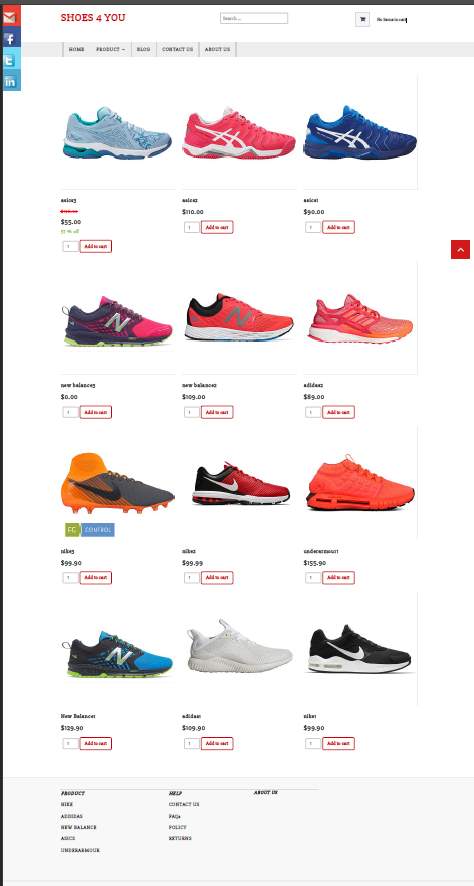
SHOPPING CART
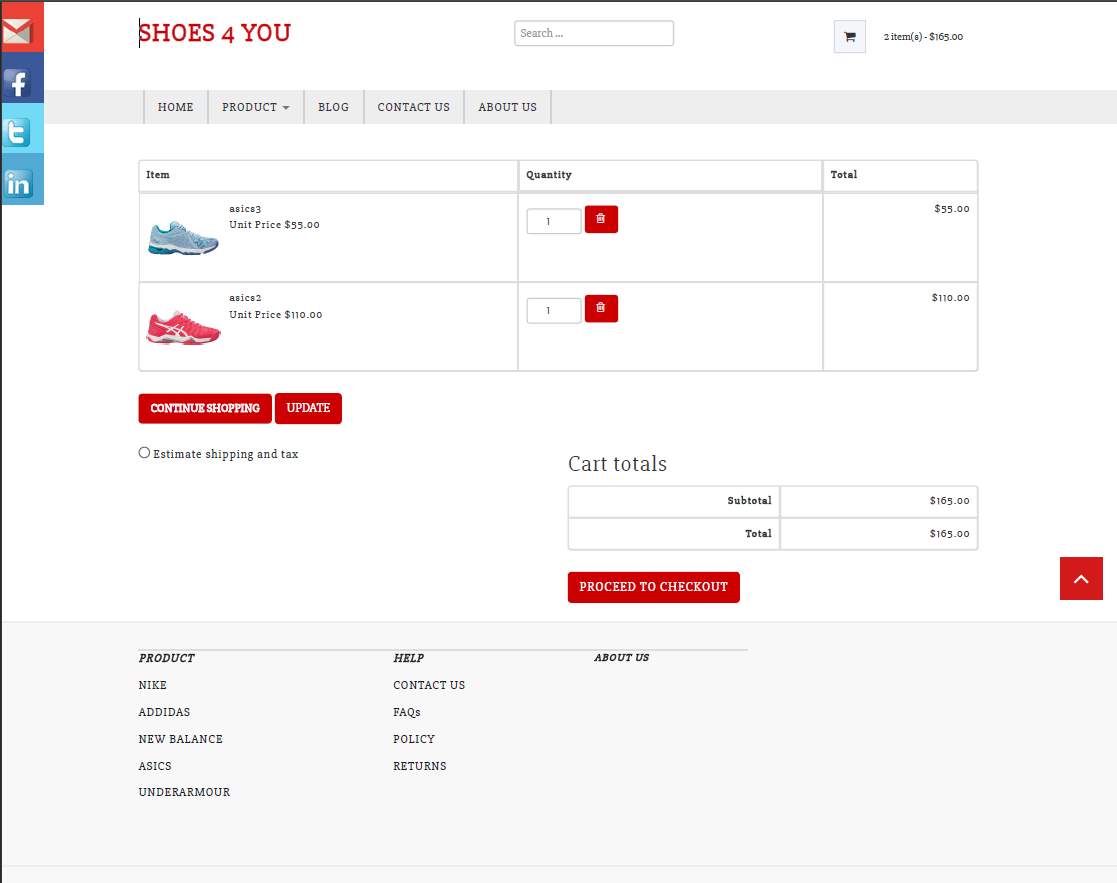
BLOG PAGE
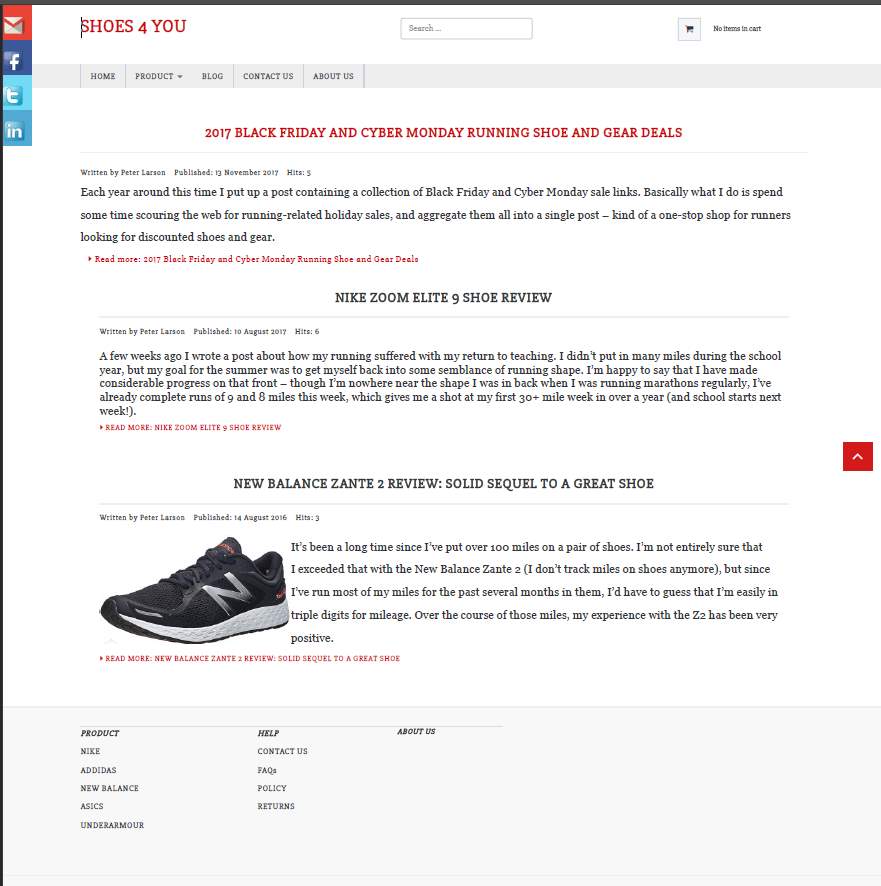
CONTACT US
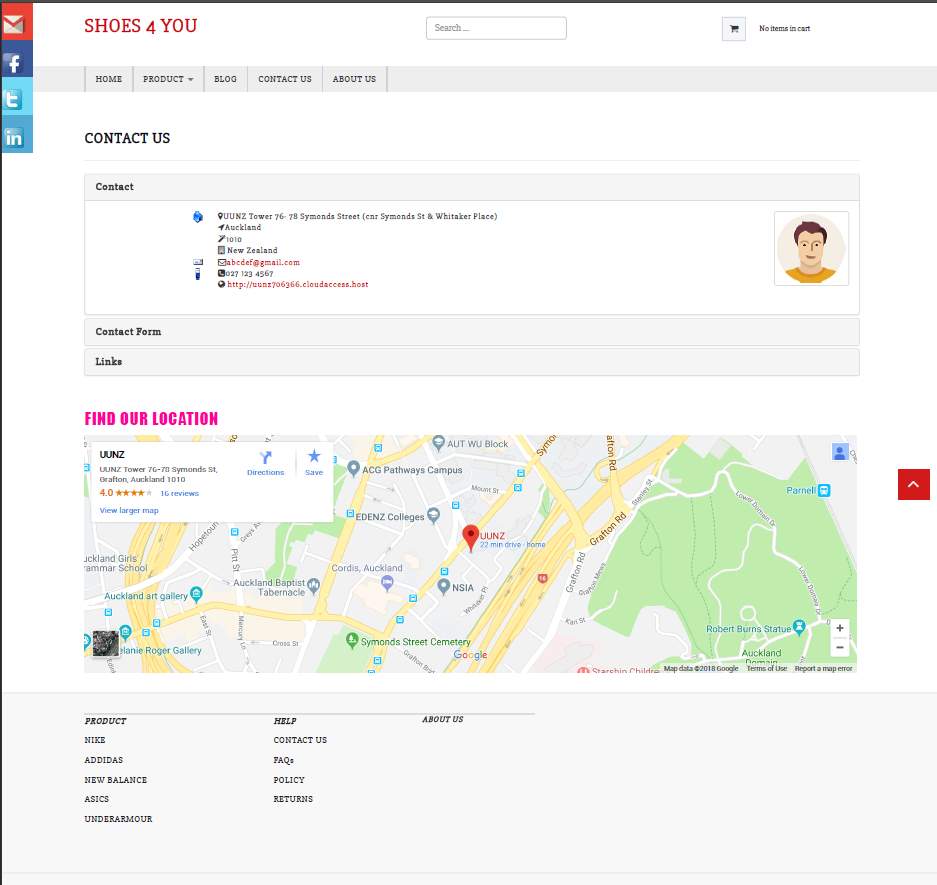
ABOUT US
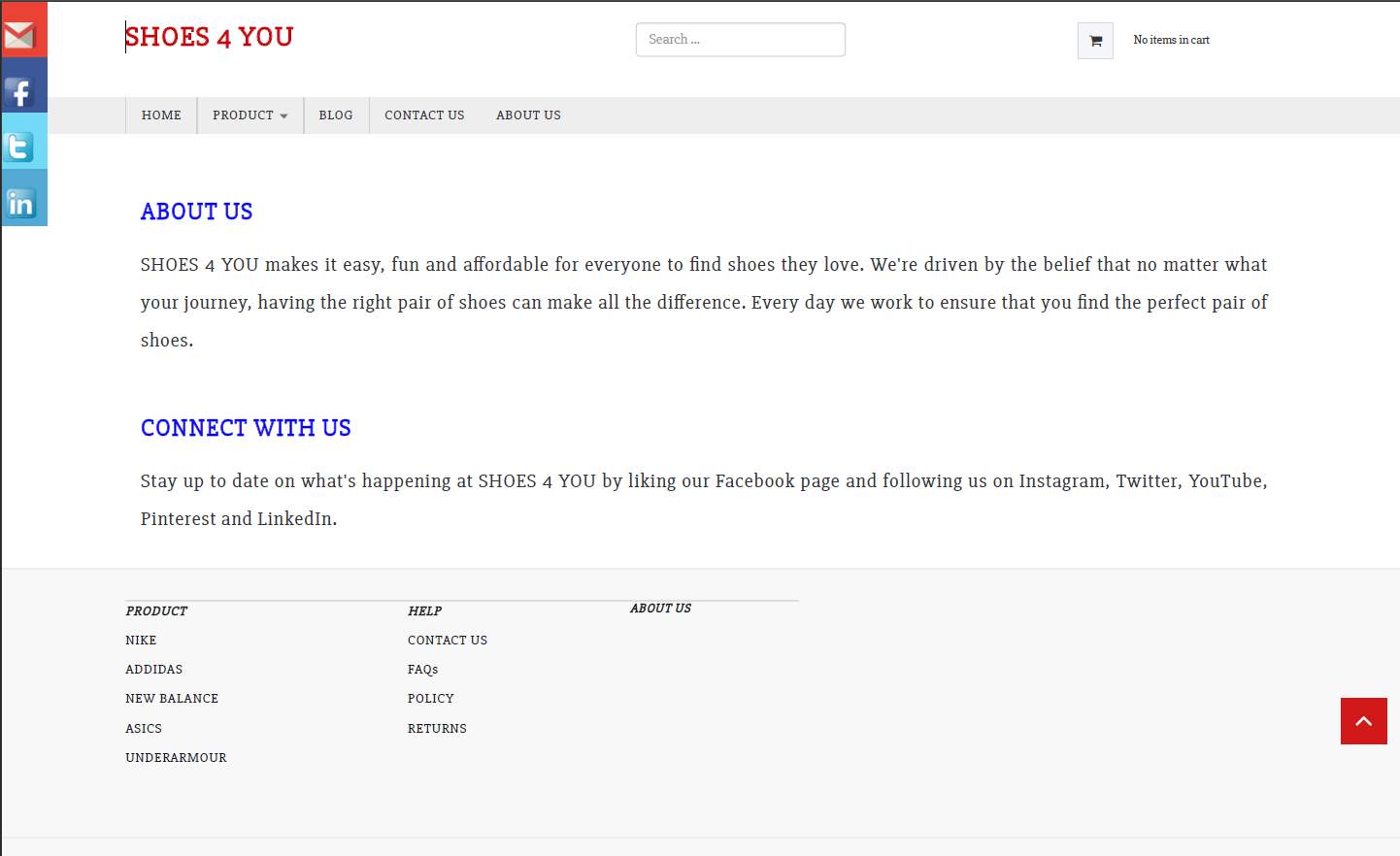
Appendix 2 — “SHOES 4 YOU” Development Journal
| DATA | ACTIVITY/DISCUSSION | RESOURCE | DURATION |
| 28th February 2018 | Set up a development environment for building an e-commerce website. Research what Joomla is and what it can do. | https://www.cloudaccess.net/ | 1 hour |
| 2nd
March 2018 |
Study how to use Joomla.
Watch tutorial 1~5. Now I have a basic understanding of Joomla. |
https://www.cloudaccess.net/joomla-knowledgebase/138-joomla-3-1/getting-started.html | 1 hours |
| 9th
March 2018 |
Continue to study Joomla. Watch video tutorial 6~15 and try to follow the videos and finish several examples, such as formatting text using the JCE Editor, using a module, creating menu items. Joomla makes it easy to build websites. But it takes time to learn to use Joomla well. | https://www.cloudaccess.net/joomla-knowledgebase/138-joomla-3-1/getting-started.html | 2.5 hours |
| 10th March 2018 | Downloaded the Shopy template and installed it into cloudaccess.net.
Downloaded and installed a shopping cart module J2Store. It can be applied to build an e-store and looks well. It is time to take the first step in starting the development journey. Making my first website is exciting. |
https://www.themeparrot.com | 2.5 hours |
| 12th March 2018 | Now the website is based on the prototype of the CloudBase3 template. So, I remove all the unnecessary elements and then add new elements related to my footwear industry, such as main menu and store name. | 1 hour | |
| 14th March 2018 | Go through several videos on Youtube and add Google map and contact form. The language of google map is the same as the browser. So, have to change the browser’s language to English.
Tried a contact form named Creative Contact Form. It is not what I want, so abandon it. |
https://www.youtube.com/watch?v=ahf4qIwOp9U&t=179s
https://www.youtube.com/watch?v=-b3silmy-eQ https://extensions.joomla.org/extension/creative-contact-form/ |
1.5 hour |
| 15th March 2018 | Go through several videos about how to use the J2Store module. Then try to add products to the website. It is not that easy to use it well. | https://www.youtube.com/watch?v=vLX7HNGP85g
https://www.youtube.com/channel/UCXEyj9ebE2N4Q2Ml0lKvuqw |
3 hours |
| 16th March 2018 | Continue to research J2Store. And add several products to the HOME page. J2Store can impact the display of the whole page. | 2 hours | |
| 20th March 2018 | Download smartslider3 and try to put it on the HOME page.
Watch several videos on Youtube to study how to use smartslider3. Some videos are for WordPress, but still useful. |
https://smartslider3.com
https://www.youtube.com/watch?v=lsq09izc1H4&list=PLSawiBnEUNfvzcI3pBHs4iKcbtMCQU0dB |
2.5 hours |
| 23rd March 2018 | Download a number of product pictures, add them to different categories according to their brands. | http://www.rebelsport.co.nz | 1 hour |
| 24th March 2018 | Download several blogs and add to the blog page with JCE Editor. In addition, add the ‘About Us’ page. | https://runblogger.com | 1 hour |
| 25th March 2018 | In order to fix a display problem, have tried to modify many settings. Still cannot solve it. So, post the question to the community forum of J2Store. | https://www.j2store.org/forum/2-general-questions/6593-the-view-of-a-page-with-j2store-is-affected-how-to-fix-it.html#22844 | 2 hours |
Cite This Work
To export a reference to this article please select a referencing stye below:
Related Services
View allRelated Content
All TagsContent relating to: "Business Strategy"
Business strategy is a set of guidelines that sets out how a business should operate and how decisions should be made with regards to achieving its goals. A business strategy should help to guide management and employees in their decision making.
Related Articles
DMCA / Removal Request
If you are the original writer of this dissertation and no longer wish to have your work published on the UKDiss.com website then please:




